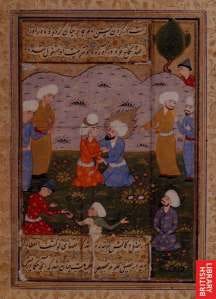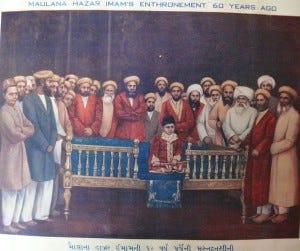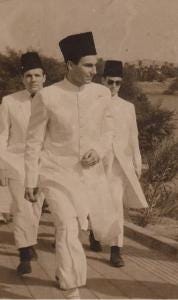The Shia Imamat: A Timeline of Major Divisions and Developments
From that early division, a host of further distinctions grew up, but the question of rightful leadership remains central. In time, the Shia were also sub-divided over this question, so that today the Ismailis are the only Shia community who, throughout history, have been led by a living, hereditary Imam in direct descent from the Prophet.
Imam Shah Karim al-Husayni Aga Khan IV
Address to both Houses of the Canadian Parliament and Senate, February 27, 2014
http://www.nanowisdoms.org/nwblog/10724/
Click here to download the poster in PDF format for classroom use
632 AD: Death of Prophet Muhammad. The Shi‘at Ali recognize ‘Ali ibn Abi Talib as the appointed successor of Muhammad in spiritual, religious and temporal matters.

As you know, the Shia divided from the Sunni after the death of the Prophet Muhammad. Hazrat Ali, the cousin and son-in-law of the Prophet, was, in Shia belief, named by the Prophet to be the Legitimate Authority for the interpretation of the faith. For the Shia today, all over the world, he is regarded as the first Imam.
Imam Shah Karim al-Husayni Aga Khan IV
Acceptance Address, Tutzing Evangelical Academy’s ‘Tolerance’ Award, May 20, 2006
http://www.nanowisdoms.org/nwblog/7706/
A number of companions, known as the Shi‘at ‘Ali, hold that Prophet Muhammad designated his cousin and son-in-law ‘Ali ibn Abi Talib as his spiritual and temporal successor, Master (mawla, wali) and Imam of the believers. Others — a small number of Meccan and Medinese companions — on the contrary, selected and appointed, after much deliberation and disagreement, Abu Bakr as the temporal successor (khalifah) of Prophet Muhammad at the Banu Saqifa assembly hall while ‘Ali ibn Abi Talib and his kinsmen were performing the Prophet’s burial rights. And so, although Abu Bakr became the first Caliph of Islam, a small number of Muhammad’s community held ‘Ali as the rightful successor and Imam of the community and support the succession rights of the Prophet’s Ahl al-Bayt. The Ahl al-Bayt refer to the Prophet Muhammad’s closest family members whom the Qur’an declares to be purified by Divine Command, including the Prophet’s cousin and son-in-law ‘Ali ibn Abi Talib, his daugther Fatimah al-Zahra, and his grandsons al-Hasan and al-Husayn, and the Imams that followed ‘Ali ibn Abi Talib, al-Hasan and al-Husayn.
I swear by the Lord that I know fully well all the messages of God that the Holy Prophet has received, the ways of fulfilment of promises made by God and of all the knowledge that science or philosophy could disclose. We, the progeny of the Holy Prophet, are the doors through which real wisdom and true knowledge will reach mankind: we are the lights of religion.
Imam ‘Ali ibn Abi Talib, (Naghul Balagha: Peak of Eloquence, tr. Sayed Ali Reza, Sayed Mohamed Askari Jafery, Khutba 123, 91)
661 AD: Death of Imam ‘Ali ibn Abi Talib. Imam al-Hasan ibn ‘Ali succeeds as the Imam of the Shi‘a Muslims.
O people, whoever knows me, knows me, and whoever does not know me, I am al-Hasan, the son of Muhammad. I am the son of the bringer of good tidings, the son of the warner, the son of the summoner to God, powerful and exalted. With His permission, I am the Shining Lamp. I am of the family of the Prophet from whom God has removed filth and whom He has purified.
Imam al-Hasan ibn ‘Ali, (January 28, 661, Wilferd Madelung, The Succession to Muhammad, 311)
670 AD: Death of Imam al-Hasan. Imam al-Husayn ibn ‘Ali succeeds as the Imam of the Shi‘a Muslims.
God gave preference to Muḥammad before all His creatures. He graced him with prophethood and chose him for His message. After he had warned His servants and informed them of what he had been sent with, God took him for Himself. We are his family (ahlihi), those who possess his authority (awliyā’), those who have been made his trustees (awṣiyā’), and his inheritors (wurathā); we are those who have more right to this position among the people than anyone else. People selfishly claimed our exclusive right to that. Yet we consented since we hated disunion and desired the well-being [of the community]. However, we know we have greater claim to that right, which was our entitlement, than those who have seized it.
Imām al-Ḥusayn ibn ‘Alī, (Arzina Lalani, Early Shi’i Thought, 30)
680 AD: Death of Imam al-Husayn during the massacre at Karbala. Some of the Shi ‘a recognize his half-brother Muhammad ibn al-Hanafiyya as the next Imam while others follow ‘Ali ibn al-Husayn Zayn al-Abidin as the next Imam.
This is he whose footprint is known to the valley of Mecca. He whom the Kaba knows and the most frequented sanctuary. This is the son of the best of all the servants of God. This is the pious, the elect, the pure, the eminent. This is Ali, whose father is the Prophet, and it was through the light of his guidance, that the darkened road changed into the straight path. This is the son of Fatima, if you are ignorant of him; and with his great-grandfather the Prophethood came to an end.
Farazdaq (d. 730), (Mumtaz Aly Tajuddin Saddik Ali, Ismailis Through History)
http://www.ismaili.net/histoire/history03/history364.html
713 AD: Death of Imam ‘Ali Zayn al-Abidin. The Zaydi Shi‘a recognize his son Zayd as the next Imam while the Imami Shia recognize his son Muhammad al-Baqir as the next Imam, followed by the Imam Ja‘far al-Sadiq.

Imam Ja‘far al-Sadiq, (al-Kulayni, Usul al-Kafi, Book 2, Chapter 17, Hadith No. 14)
765 AD: Death of Imam Ja‘far al-Sadiq, 5th Imam of the Shi‘a. The Isma‘ili Shi‘a recognize the Imam Ja‘far’s appointed successor Isma‘il and his descendants as the rightful Imams while those who later become the Twelver Shi‘a recognize Musa al-Kazim and his descendants as their Imams.

According to the majority of the available sources, he [Imām Ja‘far] had designated his second son Ismā‘īl (the eponym of the Isma‘ıliyya) as his successor, by the rule of the naṣṣ. There can be no doubt about the authenticity of this designation, which forms the basis of the claims of the Ismā‘īlīyya and which should have settled the question of al Ṣādiq’s succession in due…However, the fact remains that Isma‘il was not present at the time of the Imam al-Sadiq’s death, when three other sons simultaneously claimed his succession, though none of them could convincingly prove to have been the beneficiary of a second nass. As a result, the Imam al-Sadiq’s Shı‘ı partisans split into six groups, two of which constituted the nucleus of the nascent Isma‘iliyya.
Farhad Daftary, (The Ismailis: Their History and Doctrines, 2nd Edition, 88)
The line of Musawi Twelver Imams ends when the eleventh Imam, al-Hasan al-Askari, leaves no apparent successor; the Twelvers split into numerous groups, each with a different understanding of the succession of the Imamat (Sachedina, Islamic Messianism). The majority of the Twelver Shi‘a hold that the Twelfth Imam disappeared as a young child and await his re-appearance on the Day of Judgment.
If an Imam dies without leaving a son as his successor, it can only mean that not only he personally, but the whole line of his ancestors were not the true Imams. Thus the discontinuation of the line of the Twelvers proved that at least the last several of them were not genuine.
Wladmir Ivanow, (Brief Survey of the Evolution of Ismailism, Holland, 1952, 9)
813 AD: Death of Imam Muhammad ibn Isma‘il, 7th Imam of the Isma‘ili Shi‘a. By 899 one group of his followers, later known as the Qarmatians, recognize him as the seventh and last Imam and the awaited Qa’im and reject the Imamat of the Fatimids. Another group, later known as the Fatimid Isma‘ilis, recognize the continuity of the Imamat through the descendants of Muhammad b. Isma‘il including the Fatimids.

On the death of Muhammad b. Isma‘il, the Mubarakiyya split into two groups. A majority, identified by the Imami heresiographers as the immediate predecessors of the dissident Qarmatis, refused to accept Muhammad b. Isma‘il’s death. They acknowledged him as their seventh and last Imam, awaiting his imminent return as the Mahdi or qa’im […]. A second group, very small and extremely obscure, affirmed Muhammad b. Isma‘il’s death and now began to trace the Imamate in his progeny.
Farhad Daftary, (A Short History of the Ismailis, 36)
1021 AD: Death of Imam al-Hakim bi-amr’illah, 16th Imam of the Isma‘ili Shi‘a.

A group later known as the Druze, led by Hamzah ibn ‘Ali, proclaim that al-Hakim is the manifestation (zuhur) of the transcendent God and has gone into occultation with Hamza [a dissident Fatimid da‘i] becoming the Imam of the believers. The Druze await al-Hakim’s return at the Day of Judgment while the Fatimid Ismailis continue to recognize the Imamat of al-Hakim’s son, al-Zahir, and his descendants.
In the mountainous regions of Syria, for example, are to be found the Druzes, in their fastness in the Jebel Druze. They are really Ismailis who did not originally follow my family in their migration out of Egypt but remained with the memory of my ancestor, Al-Hakim, the Fatimid Caliph of Egypt, but they established their doctrines on lines very similar to those of the Syrian Ismailis, who, in present times, are my followers.
Imam Sultan Muhammad Shah Aga Khan III,
The Memoirs of Aga Khan III, Chapter 2, Islam, The Religion of My Ancestors
http://www.nanowisdoms.org/nwblog/1225/
1094 AD: Death of Fatimid Imam-Caliph al-Mustansir bi-llah, 18th Imam of the Isma‘ili Shi‘a.

Every student of Ismailism knows the historical accounts of that fateful night when the aged al-Mustansir unexpectedly died after a short and apparently not very serious illness, and the princes and other dependents were urgently summoned to the palace only to find that the all-powerful commander-in-chief had already placed his own son-in-law, the youngest prince Must‘ali, upon the throne, and required them to take the oath of allegiance to him. There are different versions of what had really happened – quite naturally, indeed. But it is quite clear that the eldest prince, the original heir apparent, Nizar, under one pretext or other, escaped, and took refuge in Alexandria, claiming his rights. The events happened in the full light of history, and there is very little doubt as to their real trend.
Wladmir Ivanow, (Ismaili Tradition Concerning the Rise of the Fatimids, 5)
The Nizari Ismailis recognize al-Mustansir’s eldest son and heir-designate, Nizar, as the next Imam while the Must‘alian Ismailis recognize his younger son al-Must‘ali as the next Imam. The Fatimid vizier al-Afdal effects a palace coup and places al-Musta‘li on the caliphal throne while Nizar and his family flee to Alexandria. The Nizaris recognize the continuity of the Imamat through the descendants of Nizar who find refuge in the Nizari state in Persia led by Hasan-i Sabbah. The Must‘alian line of Imams ends with al-Amir ibn Must‘ali, who dies without an apparent successor. The Tayyibi Must‘alian Ismailis, today known as the Bohras, hold that the line of Must‘alian Imams has gone into concealment with their twenty-first Imam al-Tayyib, son of al-Amir, and that this line of Imams is thereafter represented by a succession of da‘i mutlaqs (chief da‘is) up to present times.
The Ismailis themselves are divided into two parties, a division which stems from the period when my ancestors held the Fatimid Khalifat of Egypt. One party accepts my ancestor, Nizar, as the rightful successor of the Caliph of Egypt, Mustansir; whereas the other claims as Imam his other son, the Khalif Musta‘li… After the loss of the Fatimid Khalifat in Egypt, my ancestors moved first to the highlands of Syria and the Lebanon, thence they journeyed eastward to the mountains of Iran. They established a stronghold on the craggy peak of Alamut in the Elburz Mountains, the range which separates from the rest of Persia the provinces lying immediately to the south of the Caspian
Imam Sultan Muhammad Shah Aga Khan III,
The Memoirs of Aga Khan III, Chapter 2, Islam, The Religion of My Ancestors
http://www.nanowisdoms.org/nwblog/1225/
1310 AD: Death of Imam Shams al-Din Muhammad, 21st Imam of Nizari Ismailis; Nizari Ismailis split into two groups – the Qasimshahi Nizaris recognize the Imamat of Qasimshah while the Muhammadshahi Nizaris follow the Imamat of Muhammadshah.

After Shams al-Dın Muh.ammad, there occurred once again a dispute over the succession to the Imamate, splitting the line of the Nizarı imams and their followers into what became known as the Muhammad-Shahi (or Mu’minı) and Qasim-Shahi branches. The Muhammad-Shahi line of Imams, whose most famous figure was Shah Tahir Dakkanı, was discontinued about two centuries ago, while the Qasim-Shahi line has endured to the present day. The Qasim-Shahı Imams, who in modern times have carried the title of Aga Khan, an honorific meaning chief master or lord, are now the sole Nizarı Imams.
Farhad Daftary, (The Ismailis: Their History and Doctrines, 413)
1885: Death of Imam ‘Aga ‘Ali Shah His son Imam Sultan Muhammad Shah succeeds as the 48th Imam of the Nizari Ismailis.
O’ Jamat! Do not consider us small! We are the descendant of the Prophet and Hazrat Ali, the Commander of the Faithful, was our great-grandfather. Hazrat Bibi Fatima Khatun-i Jannat was our great grandmother. We are the Light of both Ali and the Prophet. We are young in age but exalted. Mawla Murtada Ali was small in stature but in his youth he conquered the fort of Khaybar… In the physical world he used to eat bread made of barley but in reality he could reach the other end of the world in a fraction of a second and he could turn mountains in to pieces. Whoever yearned for the help from Mawla Murtaza Ali he used to fulfill their wishes and ease their difficulties. I am the great-grandson of Murtada ‘Ali. Hazrat Imam Zayn al-Abidin was also a young Imam but he was like Murtada ‘Ali in his knowledge and ability. My Light comes from them.”
Imam Sultan Muhammad Shah Aga Khan III, (Address made in Bombay, September 1, 1885 quoted in Michele Boivin, Le Renovation du Shiisme Ismailien en Inde et au Pakistan, 196)
1887: The bulk of Muhammad-Shahi Nizaris transfer their allegiance to Imam Sultan Muhammad Shah Aga Khan III.
Meanwhile, the Syrian Muhammad-Shahis had lost contact with their fortieth Imam, Amır Muhammad al-Baqir. Since 1210/1796 they had not heard from this Imam, who, like his predecessors, had been living in India. In 1304/1887, the Syrian Muhammad-Shahi Nizarıs sent a delegation to India to locate the descendants of Amir Muhammad al-Baqir, who was thought to have gone into concealment. The delegation failed in its search, and soon afterwards the majority of the Syrian Muhammad-Shahi Nizaris transferred their allegiance to the Qasim-Shahi line, then represented by Aga Khan III, who had earlier assumed the imamate in Bombay.
Farhad Daftary, (The Ismailis: Their History and Doctrines, 489)
1957: Death of Imam Sultan Muhammad Shah Aga Khan III His grandson Imam Shah Karim al-Husayni Aga Khan IV succeeds as the 49th and present Imam of the Nizari Ismailis.

Ever since the time of my ancestor ‘Ali, the first Imam, that is to say over a period of thirteen hundred years, it has always been the tradition of our family that each Imam chooses his successor at his absolute and unfettered discretion from amongst any of his descendants whether they be sons or remoter male issue… And in these circumstances and in view of the fundamentally altered conditions in the world in very recent years due to the great changes which have taken place including the discoveries of atomic science I am convinced that it is in the best interest of the Shi‘a Muslim Ismailian Community that I should be succeeded by a young man who has been brought up and developed during recent years and in the midst of a new age and who brings a new outlook on life to his office as Imam. For these reasons and although he is not now one of my heirs, I APPOINT my grandson KARIM, the son of my son, ALY SALOMONE KHAN to succeed to the title of AGA KHAN and to be the Imam and Pir of all my Shia Ismailian followers.
Will of Imam Sultan Muhammad Shah Aga Khan III
http://www.nanowisdoms.org/nwblog/10233/
Remarks by the present Aga Khan about the Shia and Ismaili Imamats
Interviewer: When did this turning-point as far as the Ismailis come and why was it necessary?
Aga Khan IV: It was the sixth generation after Ali where the Imam of the time, called Ja‘far Sadiq, had four sons. Isma‘il was the eldest, and the Sevener Shia – the Isma‘ilis are Sevener Shia – followed the branch of the family led by Isma‘il, and that’s why they are called Isma‘ilis….Interviewer: And your own descent as head of the Isma‘ilis is from…?
Aga Khan IV: Is from Isma‘il.Interviewer: And where do you rank?
Aga Khan IV: I am the forty-ninth.Interviewer: You are the forty-ninth Imam?
Aga Khan IV: Yes, Yes.BBC Radio 4 Interview with Michael Charlton, September 6, 1979
http://www.nanowisdoms.org/nwblog/1988/
Interviewer: You are called the living Imam, what exactly does that mean?
Aga Khan IV: Well the Shia history has followed the same sort of historical developments all hereditary offices have followed, where there have been differences of opinion on who was the legitimate successor to the predecessor, whether it was a secular or religious office. In the case of the Shia Muslims, the Shia branch of Islam split and one branch of the Shia Muslims accepted the concept of the Imam in hiding, the invisible Imam, because the twelfth Imam disappeared as a very young child, and our branch of Shia Islam, in that particular generation of the family, accepted the legitimacy of the eldest son, Isma‘il, as being the appointed Imam to succeed and that is why they are known as Ismailis. And that branch of the family has continued today hereditarily and that is why there is a living Imam for the Ismaili Muslims.
CBC Man Alive Interview, October 8, 1986
http://www.nanowisdoms.org/nwblog/3268/
Interviewer: What makes the Ismailis different from the mainstream Shiite Islam?
Aga Khan IV: Probably that there is a living Imam who traces his family back to Hazrat Ali. The majority of the Shia today are known as the Twelver Shia and they believe in the hidden Imam.
Independent Television ITV Interview, June 4, 1985
http://www.nanowisdoms.org/nwblog/3134/
The leadership is hereditary, handed down by Ali’s descendants, and the Isma‘ilis are the only Shi‘a Muslims to have a living Imam, namely myself. The other Shia — the Twelvers — revere a “hidden” Imam who will return on the Day of Judgement to take part in the final judgement. It is the presence of the living Imam that makes our Imamat unique.
Imam Shah Karim al-Husayni Aga Khan IV
“The Power of Wisdom”, Politique Internationale, March 1, 2010
http://www.nanowisdoms.org/nwblog/9473/
In time, the Shia were also sub-divided over this question, so that today the Ismailis are the only Shia community who, throughout history, have been led by a living, hereditary Imam in direct descent from the Prophet.
Imam Shah Karim al-Husayni Aga Khan IV
Address to both Houses of the Canadian Parliament and Senate, February 27, 2014
http://www.nanowisdoms.org/nwblog/10724/
We conclude with the remarks of Imam Shah Karim al-Husayni which emphasize the continuity of the Imamat throughout history and his role as the Living Imam in fulfilling the mandate of the institution:
The Imam is a transitory being, who forms a link between the past and the future. For this reason, ensuring the continuity of the institution and its ability to fulfil its role is what my life is all about.
Imam Shah Karim al-Husayni Aga Khan IV, [Translation]
“The Confessions Of The Aga Khan”, Paris Match, February 3, 2005
http://www.nanowisdoms.org/nwblog/7190/
The leadership is hereditary, handed down by Ali’s descendants, and the Isma‘ilis are the only Shi‘a Muslims to have a living Imam, namely myself. The other Shia — the Twelvers — revere a “hidden” Imam who will return on the Day of Judgement to take part in the final judgement. It is the presence of the living Imam that makes our Imamat unique.
Imam Shah Karim al-Husayni Aga Khan IV
“The Power of Wisdom”, Politique Internationale, March 1, 2010
http://www.nanowisdoms.org/nwblog/9473/
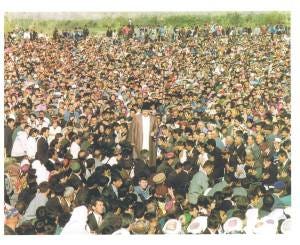


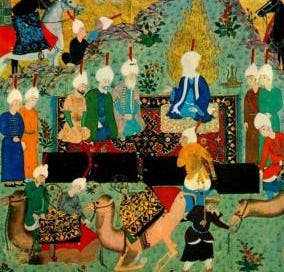


![Imam Muhammad al-Baqir [A.S.] teaching in Medina. Painting by Qasim Ali, ca. 1525 Imam Muhammad al-Baqir [A.S.] teaching in Medina. Painting by Qasim Ali, ca. 1525](https://substackcdn.com/image/fetch/$s_!I-NS!,w_1456,c_limit,f_auto,q_auto:good,fl_progressive:steep/https%3A%2F%2Fsubstack-post-media.s3.amazonaws.com%2Fpublic%2Fimages%2Fddf4c38c-4141-4a8f-b7bc-c6e675d0f18c_284x300.jpeg)
